ISSN 1411 – 0067 Jurnal Ilmu-Ilmu Pertanian Indonesia. Volume 5, No. 2, 2003, Hlm. 71 - 76 71
POPULASI DAN SIKLUS HIDUP TUMBUHAN LANGKA
Rhizanthes loweii. (BECC) HARM (RAFFLESIACEAE)
DI TAMAN NASIONAL KERINCI-SEBLAT
RESORT KATENONG
THE POPULATION AND LIFE HISTORY OF RARE SPECIES OF Rhizanthes loweii
(BECC). HARMS AT KATENONG KERINCI-SEBLAT NATIONAL PARK
Agus Susatya
Jurusan Kehutanan, Fakultas Pertanian Universitas Bengkulu
ABSTRACT
Population dynamic of species is one of ecological information that is required to develop a proper conservation
management scheme. Yet, It is rarely used to develop current conservation management schemes. Study on
population dynamics of species of Rafflesiaceae is an important step to initiate conservation purposes considering
that all these species are classified as endangered species, and is only few studied in more detail analysis. Therefore,
the objectives of the research are to know the population dynamic population structure, life cycle, and the
mortality of Rhizanthes loweii.. Study was conducted in di Air Musno, Kerinci-Seblat N. P , Bengkulu.
Diameter of flower buds of Rhizanthes loweii was measured every 10 days from April to July 2002. Number
of flower bud die and flowering was recorded, and identified its sex. The diameter growth, then, was used to
construct Letkovitch transtition matrix, life cycle, and ë, instrinctive rate of increase. Sensitivity Analysis was
conducted to determine critical growth phase by examing the impact of the changing of value of matrix element,
Pij, to the value of i ë. Rhizanthes loweii consisted of developmental phase I, II, III, IV, flowering with
respectively 19, 7, 2, 2, and 2 flower buds. It had l value of 0.762, and therefore the population would
decrease through time. It was expected that the species would be undergoing local extinction within 30 months
or 2.5-3 years, if there was no new flower bud emerging from host plant. Three buds was die due natural causes,
while five others due to being cut by people. The former occored at phase I with diameter range of 0.5-0.90 cm.
Phase I also became the critical phase of the species.
Keywords: critical stage, flower bud, stage development, life-cycle, transition matrix.
ABSTRAK
Dinamika populasi merupakan salah satu informasi ekologi yang sangat dibutuhkan dalam menyusun skema
pengelolaan kawasan konservasi. Sayangnya banyak skema pengelolaan tidak berdasarkan dengan pada faktor
dinamika populasi. Selama ini kajian mengenai dinamika populasi dan pertumbuhan jenis-jenis Rafflesia masih
sangat sedikit dan kurang terperinci. Oleh karena itu, tujuan dari penelitian ini difokuskan pada dinamika populasi
termasuk struktur, siklus hidup (life cycle ), mortalitas, dan untuk mengetahui laju model, fase, dan laju
pertumbuhan diameter knop. Penelitian dilakukan di Air Musno, Air Manjo dan Seblat Ulu dalam Kawasan
Taman Nasional Kerinci-Seblat, Propinsi Bengkulu, dan di Muara Sako , Sumatra Barat. Penelitian dilakukan
dengan mengukur diameter knop jenis10 hari selama bulan April sampai Juli 2002. Setiap pengamatan dicatat
jumlah knop yang mati dan yang mekar. Data pertumbuhan diameter kemudian dipakai sebagai dasar untuk
menyusun matrik transisi Letkovitch dan siklus hidup, dan ë. Sensitifitas analisis dilakukan untuk mencari fase
pertumbuhan yang kritis dengan melihat pengaruh perubahan probabilitas pada element matrik Pij pada nilai ë.
Rhizanthes loweii mempunyai i satu tahapan pertumbuhan di fase cupula, 2 fase di tahapan bractea, dan satu
fase di tahapan perigon. Jenis ini mempunyai total populasi sebesar 32 knop, dengan struktur populasi yang
terdiri dari fase I, II, III, IV, M masing-masing dengan 19, 7, 2, 2, dan 2 knop. Jenis ini mempunyai populasi
dengan nilai l sebesar 0.762. Hal ini berarti populasi ini akan mengalami penurunan terus. Dengan nilai tersebut,
jenis ini diperkirakan akan mengalami kepunahan lokal dalam jangka waktu 30 bulan, atau 2.5- 3 tahun. Kematian
knop terjadi di fase I, sebanyak 3 knop. Sedangkan 5 knop lainnya mati diakibatkan oleh tangan jahil. Fase I
dengan rentang diameter 0.5-0.90 cm merupakan fase yang kritik dari populasi
Kata kunci : siklus hidup, matrik letkovitch, fase pertumbuhan, knop.
Susatya, A. JIPI 72
PENDAHULUAN
Sifat biologi dan atribut ekologi dari jenis-
jenis Rafflesiaceae menyebabkan hambatan jenis-
jenis tersebut untuk menjaga tingkat populasi yang
aman dari ancaman kepunahan. Kondisi ini
diperburuk oleh tekanan ekternal yang makin kuat,
seperti fragmentasi dan perusakan habitat oleh
manusia. Sifat biologi tersebut antara lain adalah
dibutuhkannya bunga jantan dan betina (diocious)
yang mekar pada saat bersamaan (sinkronisasi),
dan adanya agen penyerbuk agar proses
penyerbukan bunga terjadi. Sinkronisasi ternyata
merupakan peristiwa yang jarang terjadi, kalau ada
dua individu yang mekar dalam waktu bersamaan
biasanya berkelamin jantan atau betina saja
(Hidayati et al., 2000).
Sampai saat ini belum ada tindakan
konservasi yang menyeluruh, terpadu, dan jelas
untuk jenis-jenis Rafflesia. Padahal jenis tersebut
merupakan jenis yang harus segera dilakukan
tindakan konservasi. Hal ini disebabkan karena
data mengenai ekologi dan status populasi jenis-
jenis tersebut belum lengkap tersedia.
Atribut ekologi terdiri atas hubungan yang
erat antar penyusun komunitas di mana jenis
Rafflesia berada, dan status populasi dari jenis
Rafflesia sangat diperlukan untuk menyusun
pengelolaan konservasi yang tepat. Data awal
mengenai komunitas/ekosistim paling tidak sudah
tersedia untuk jenis R. arnoldii, R. haseltii, dan
Rhizanthes loweii di kawasan Taman Nasional
Kerinci-Seblat Propinsi Bengkulu (Susatya et al.,
2001), sedangkan data mengenai populasi belum
banyak tersedia untuk tiga jenis di atas. Padahal
status dan atribut populasi, termasuk di dalamnya
pengaruh iklim mikro terhadap perilaku individu
jenis-jenis di atas, merupakan kunci untuk
perlindungan dan pengelolaan jenis-jenis langka
dan terancam (Primack.1993).
Tujuh dari 13 jenis Rafflesia telah masuk
dalam IUCN Red List of Threatened Plants
(Walter and Gillett 1998), dan sebagian besar
adalah jenis-jenis yang ada di Semenanjung
Malaysia. R. arnoldii, walaupun dianggap
sebagai jenis yang paling terancam, dan
membutuhkan tindakan konservasi yang segera,
ternyata dimasukkan dalam kategori konservasi :
insufficiently known, berdasarkan alasan data
populasinya kurang cukup dan tidak diketahui.
Hal ini bisa menimbulkan persepsi yang salah
dalam menentukan kebijaksanaan konservasi.
Masuknya R. arnoldii dalam kategori
tersebut cukup mengherankan, mengingat jenis
ini yang paling pertama ditemukan pada hampir
dua ratus tahun yang lampau, dan yang
mempunyai bunga terbesar di dunia. Rhizanthes
loweii, lebih-lebih, belum dimasukan dalam
kategori konservasi IUCN, padahal dari segi
biologi jenis ini sangat layak masuk dalam salah
satu kategori. Oleh karena itu, perlu dibutuhkan
data mengenai atribut populasi untuk menyusun
kebijaksanaan konservasi bisa maksimum, dan
memasukkan R. loweii di TNKS dalam kategori
konservasi IUCN yang sesuai.
Data atribut populasi yang tersedia untuk tiga
jenis dari keluarga Rafflesiaceae di lokasi
penelitian hanya ukuran populasi saja. Jenis-jenis
tersebut ternyata mempunyai populasi yang sangat
kecil. Populasi R. arnoldii terdiri dari tiga
subpopulasi dengan jumlah inividu dari 3, 9, dan
12 kuncup. R. haseltii hanya satu populasi dengan
3 kuncup, dan Rhizanthes loweii 11 kuncup
(Susatya et al., 2001).
Ukuran populasi tersebut di atas tersebut
masih jauh dari jumlah minimal populasi yang bisa
kekal (minimal viable population) yang dianjurkan
Meijer (1987). Lebih lanjut, ukuran populasi yang
kecil juga menyebabkan berbagai masalah yang
dapat mempercepat kepunahan (Primack. 1993).
Data ukuran populasi saja tentu saja jauh dari
memadai untuk sebuah tindakan konservasi.
Beberapa atribut populasi lainnya untuk
memperkirakan apakah laju kepunahan lebih cepat
atau lebih lambat dari yang kita perkirakan sangat
perlu dibutuhkan. Atribut populasi tersebut antara
lain pertumbuhan individu kuncup, mortalitas
kuncup, jumlah kuncup baru yang muncul,
persentase kuncup yang berbunga, jenis kelamin
bunga yang mekar, dan ‘life history’ (Hidayati
2000), ‘critical size’ kuncup yang menentukan
dinamika populasi, jenis serangga penyerbuk, dan
pengaruh lingkungan terhadap atribut populasi.
Oleh karena itu tujuan dari penelitian ini ialah
untuk melakukan analisis populasi, menyusun
Populasi dan siklus hidup tumbuhan langka Rhizanthes loweii
JIPI 73
model life history, menentukan critical size’
kuncup yang berpengaruh terhapat dinamika
populasi, dan mengetahui pola pertumbuhan dari
R. loweii.
METODE PENELITIAN
Penelitian dilakukan di Resort TNKS
Katenong, selama bulan April sampai dengan juli
2002. di lokasi penelitian, masing-masing individu
R. loweii diikuti cohort nya selama penelitian
Tiap sepuluh hari sekali diameter kuncup, jumlah
kuncup, jumlah kuncup yang berbunga, jumlah
kuncup yang baru, demikian juga suhu, dan
kelembaban udara dicatat. Pengamatan ini
dilakukan bersamaan dengan pengamatan
populasi. Penentuan waktu pengamatan sepuluh
hari sekali, berdasarkan atas pertumbuhan yang
mengikuti model eksponensial, di mana pada
stadium akhir laju pertumbuhannya jauh lebih
cepat daripada stadium awal (Hidayati et al.,
2000). Data di atas kemudian digunakan untuk
menyusun struktur populasi, laju mortalitas/
survival, pertumbuhan kuncup, dan menyusun
‘life history’, informasi yang penting untuk dasar
konservasi.
Populasi yang tercatat kemudian dicari pola
phase pertumbuhan. Pola fase pertumbuhan
diduga dengan melihat physiognomi dari
pertumbuhan knop seperti: (1) cupula masing
melingkupi knop; (2) bractea mulai kelihatan
dan cupula sudah mulai pecah; (3) perigon sudah
mulai tampak; dan (4) mekar. Pada ciri
physiognomi tersebut di atas, pengamatan
dilakukan untuk menentukan persentase luasan
cupula, bractea, dan perigone Perbedaan
physiognomi pertumbuhan ini kemudian digu-
nakan untuk menentukan ‘life history’ dari jenis
di atas. Di samping perbedaan ciri di atas,
perbedaan laju pertumbuhan diameter juga
digunakan untuk menentukan phase pertumbuhan.
Sedangkan laju pertumbuhan merupakan
perbedaan dari dua pengukuran diameter knop
yang berurutan.
Fase pertumbuhan di atas kemudian,
digunakan untuk menyusun ‘life history’ dan
mengetahui ‘critical size’ diameter dari kuncup
yang berpengaruh terhadap turun dan naiknya
populasi. Dinamika pertumbuhan knop
kemudian didekati dengan ‘Transition Matrix’
(Crawley. 1991) untuk mengetahui ‘critical size’.
Analisis sensitifitas dilakukan secara simulasi
dengan mengubah nilai aij, ditambah dengan 25%
atau dikurangi 25%, dan menghitung kembali l.
Persentase perubahan l yang terbesar
menunjukkan bahwa pada fase pertumbuhan
tersebut merupakan fase yang paling sensitif
terhadap perubahan.
HASIL DAN PEMBAHASAN
Rhizanthes lowii (Becc) Harms
Jenis ini merupakan salah satu jenis dengan
ukuran bunga mekar yang terkecil di antara
anggota keluarga Rafflesiaceae. Jenis ini
mempunyai warna putih di perigon dan warna
merah kecoklatan di ujung perigon. Seperti
anggota genus Rafflesia, jenis ini unisex,dengan
variasi kelengkapan organ sexualnnya. Diameter
perigon berkisar antara 6-12 mm di bagian dasar
dan berangsur-angsur menyempit ke arah ujung
perigo. Permukaan atas perigon berbulu. Tinggi
columna tengah sebesar 10 mm. Bunga jantan
dengan antera yang membentuk cincin setebal 4
mm mengelilingi disk, dengan organ ovarium yang
samar (rudimentary) (Meiyer and Velkamp,
1988).
R. loweii mempunyai sebaran geografi dari
Sumatra, Semenanjung Malaysia, dan Kalimantan.
Di Sumatra jenis ini pernah tercatat dijumpai di
Gunung Leuser, Sibolangit, Gunung Dempo,
Sumatra Selatan, Penanggungan, Lampung dan
Bengkulu (Meiyer and Velkamp, 1988). Di
Bengkulu, jenis ini dijumpai dan dikoleksi
pertama kali oleh Koorders di perkebunan
Subanayam 3 November 1917, dan baru tahun
2001 dijumpai di lokasi Air Manjo, TNKS
Katenong I (Susatya et al., 2001a).
Total populasi dari bakal bunga sebanyak 32
knop. Ukuran populasi ini jauh lebih banyak dari
pada jenis Rafflesia arnoldii dan R. haseltii, yang
dalam satu masa mereka mempunyai populasi
tidak lebih dari 10 knop (Susatya et al., 2001).
Susatya, A. JIPI 74
Hanya saja apakah ukuran tersebut di atas sudah
mencukupi ukuran populasi (minimum viable
population), kita tidak tahu. Biasanya ukuran
populasi yang kecil, menyebabkan kepunahan
lokal secara otomatis.
Ukuran populasi yang kecil menyebabkan
suatu populasi peka terhadap kepunahan (Primack,
1993). Ukuran populasi yang turun, sampai
melewati ambang populasi tertentu, akibat dari
fragmentasi dan kerusakan kualitas habitat oleh
manusia, akan menyebabkan laju yang lebih cepat
menuju ke arah kepunahan.
Dengan kata lain populasi dengan ukuran
lebih kecil akan lebih cepat punah dengan populasi
yang mempunyai individu yang banyak. Data
mengenai ambang populasi untuk tumbuhan ini
belum banyak tersedia. Ambang populasi banyak
tersedia bagi hewan (Primack. 1993).Berger
(1990) memberikan contoh yang sangat bagus
bagaimana ukuran populasi menentukan kepekaan
jenis terhadap kepunahan.
Berer menganalisis data cohort selama 70
tahun dari dua ukuran populasi yang berbeda dari
kambing gunung (bighorn sheep). Hasil
analisisnya memperlihatkan bahwa populasi
dengan jumlah individu kurang dari 50 ekor
mengalami kepunahan dalam jangka waktu 50
tahun, sedangkan populasi dengan jumlah lebih
100 ekor tetap berkembang dan tidak mengalami
kepunahan.
Oleh karena itu, Berger menyimpulkan bahwa
ukuran populasi minimum 100 ekor dibutuhkan
menghindarkan kambing gunung dari kepunahan,
sedangkan ukuran populasi di bawah 50 ekor akan
menyebabkan kepunahan jenis dalam jangka
pendek.
Siklus Hidup (Life Cycle)
Jenis Rhizanthes loweii ditemukan pada
lokasi yang sama dengan jenis R. arnoldii. Jenis
ini mempunyai ukuran yang jauh lebih kecil dari
dua jenis terdahulu. Pada saat bunga mekar
diameter mencapai 14-15 cm, dengan warna putih
(Susatya et al., 2001). Berdasarkan analisis laju
pertumbuhan jenis ini mempunyai 4 tahap
pertumbuhan knop, di mana tahapan I merupakan
fase cupula, tahapan II merupakan fase bractea,
tahapan III merupakan fase bractea dan perigon,
dan tahapan IV merupakan fase perigon. Fase
mekar akan dicapai pada diameter knop 10-13 cm,
jauh lebih kecil dari jenis-jenis Rafflesiaceae.
Perbedaan fase pertumbuhan di atas akan
mempengaruhi laju pertumbuhan. Pola
pertumbuhan dari jenis ini mengikuti model
pertumbuhan eksponensial (Grafik 1). Secara
umum Laju pertumbuhan fase II, III, dan IV
adalah 2, 12, dan 107 kali lebih cepat
dibandingkan dengan fase I. Laju pertumbuhan
pada fase IV jenis ini jauh lebih tinggi
dibandingkan dengan Laju pertumbuhan di fase
yang sama dari jenis R. hasseltii dan Rarnoldi
(Susatya et al., 2002).
Tabel 1. Kisaran diameter, rata-rata dan standart deviasi laju pertumbuhan Rhizanthes loweii
Komponen
Fase ke
Fase Pertumbuhan
I II III IV
Kisaran kelas diameter (cm x 100) 0.50-0.94 1.4-2.8 2.96-4.25 4.25-5.35
Rata-rata laju pertumbuhan (cm x 100) 6.940 13.69 72.00 642.00
Std.deviasi laju pertumbuhan (cm x 100) 5.05 8.11 2.00 101
Analisis perubahan pertumbuhan dari data
diameter memperlihatkan pola sebagai berikut.
Selama pengamatan, probabilitas knop di fase I
untuk tetap pada fase yang sama sebesar 68%,
sedangkan 32% nya akan berubah menuju ke fase
II, probabilitas knop di fase II untuk tetap pada
fase yang sama adalah 29%, sedangkan 71% nya
berubah ke fase III, probabilitas knop di fase III
ke fase V, fase IV ke V masing-masing 100%.
Selama pengamatan terjadi mortalitas sebanyak
Populasi dan siklus hidup tumbuhan langka Rhizanthes loweii
JIPI 75
8 knop, 5 di antaranya diakibatkan oleh tangan
jahil. Mortalitas alami terjadi pada fase I. Dari
data ini dapat disusun matrik transisi dan siklus
hidup dari jenis tumbuhan ini sebagai berikut.
I II III IV M
0.68 0.32 0 0 0
0 0.29 0.71 0 0
0 0 0 0 1
0 0 0 0 1
0 0 0 0 1
Matrik 1: Matrik Transisi dari jenis Rhizanthes
loweii . Elemen matrik Pii menunjukkan
probabilitas individu knop yang tetap pada fase
awalnya. Pij menunjukkan probabilitas individu
knop di fase i berkembang menjadi fase j.
Analisis dengan matrik transisi di atas dengan
mempertimbangkan struktur populasi yang terdiri
atas fase I, II, III, IV dengan 19 , 7, 2, 2, dan 2
individu, mendapatkan nilai ë sebesar 0.762.
Nilai ini memperlihatkan bahwa populasi ini
akan terus menurun dengan berjalannya waktu,
jika tidak ada pertambahan knop baru. Pola yang
sama terjadi pada jenis R. arnoldii dan R. haselti
(Susatya et al., 2002).
Analisis sensitifitas dengan penurunkan
probabilitas pada elemen matrik P11 dan P22 atau
menaikkan probabilitas knop untuk berkembang
ke fase yang lebih tinggi pada masing-masing
elemen matrik di atas sebesar 25% akan
menyebabkan persentase penurunan nilai ë
sebesar –9.37% dan – 5.07%. Bila ini terjadi
maka laju penurunan populasi jauh lebih cepat
dari yang diperkirakan. Sebaliknya kenaikan
probabilitas untuk tetap di fase yang sama
menyebabkan persentase kenaikan nilai ë sebesar
masing-masing 10. 29% dan 5. 47%. Dari
dampak perubahan probabilitas terumbuhan
populasi, terhadap ë di atas, bisa disimpulkan
bahwa fase I merupakan fase kritik. Fase
pertumbuhan ini mempunyai kisaran diameter dari
0.5 sampai 0.94 cm.
I
II
III
?
I
M
Gambar 1. Siklus hidup Knop jenis Rhizanthes loweii.
Lingkaran menggambarkan fase pertumbuhan. Tanda panah menunjukkan
Perubahan dari suatu fase pertumbuhan ke fase yang lebih tinggi.
Tanda panah yang terputus menunjukkan bahwa perubahan dari phase III ke
M sangat cepat . Sedangkan phase M ke I tidak diketahui sampai sekarang
KESIMPULAN
Rhizanthes loweii mempunyai 4 fase
pertumbuhan, yang terdiri satu di fase cupula, 2
fase di tahapan bractea, dan satu fase di tahapan
perigon. Jenis ini mempunyai total populasi
sebesar 32 knop, dengan struktur populasi yang
terdiri dari fase I, II, III, IV, M masing-masing
dengan 19, 7, 2, 2, dan 2 knop. Jenis ini
mempunyai populasi dengan nilai l sebesar
0.762. Hal ini berarti populasi ini akan
mengalami penurunan terus. Dengan nilai
tersebut, jenis ini diperkirakan akan mengalami
kepunahan lokal dalam jangka waktu 30 bulan,
atau 2.5- 3 tahun, jika tidak ada pertambahan
populasi. Kematian alami knop terjadi di fase I,
Susatya, A. JIPI 76
sebanyak 3 knop. Fase I dengan rentang diameter
0.5-0.90 cm merupakan fase yang kritik dari
populasi. Fase ini sangat penting mengingat fase
ini akan menentukan ukuran populasi dan laju
kepunahan.
UCAPAN TERIMA KASIH
Terima kasih sebanyak-banyaknya diucapkan
kepada personil SMG-TNKS Yayasan Kehati, Dr.
Ani Mardiastuti, Teman-teman di Jurusan
Kehutanan, A. Duner, A. Asyari, dan Pak . Arpan,
Chen.
DAFTAR PUSTAKA
Berger. J. 1990. Persistence of different-sized
population: An emphirical assessment of
rapid extinctions in bighorn sheep.
Conservation Biology 4:91-98.
Crawley. R. 1991. Terrestrial Plant Ecology.
Oxford Press. Inc.
Hidayati, SN, JM Baskin and J.L. Walck. 2000.
A contribution to the life history of the rare
Indonesian holoparasite Rafflesia patma
(Rafflesiaceae). Biotropica 32 (3): 408-414.
Meijer. 1987. Populasi study of species of
Rafflesiaceae. Unpublished draft proposal.
Meiyer. W., and J.F. Veldkamp. 1988. Revision
of Rhizanthes. BLUMEA 33 No;2. :329-342.
Primack. R. B. 1993. Essesntials of conservation
biology. Sinauer Inc.
Susatya, A., Wahyudi A, A. Asyari, A Dunner,
dan E. Sofyan. 2001a. Kajian Sebaran dan
ekologi jenis-jenis Rafflesia di TNKS
Propinsi Bengkulu. Kerjasama Yayasan
Kehati dan Jurusan Kehutanan UNIB.
Susatya, A. K. Mat Salleh, A. Hikmat, A. Latif.
2001. Distribution and Conservation of
Indonesian Rafflesia. Seminar Konservasi
Puspa Langka Rafflesia, Bogor, Mei 2001.
Susatya, A. A. Dunner, dan A. Asyhari. 2002.
Status Populasi Tiga Jenis Rafflesiaceae di
Taman Nasional Kerinci-Seblat. Bengkulu.
Yayasan Kehati dan Jurusan Kehutanan.
UNIB.
Walter, K.S. and H.J. Gillett (eds). 1998. 1997
IUCN red list of threatened plants. Compiled
by the World Conservation Monitoring
Centre. IUCN-The World Conservation
Union. Gland, Switzerland.
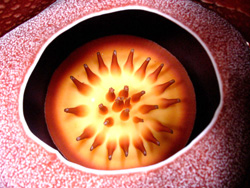
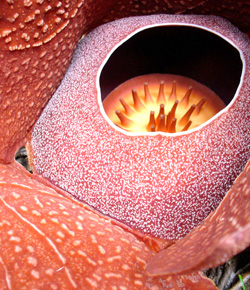
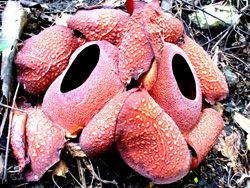



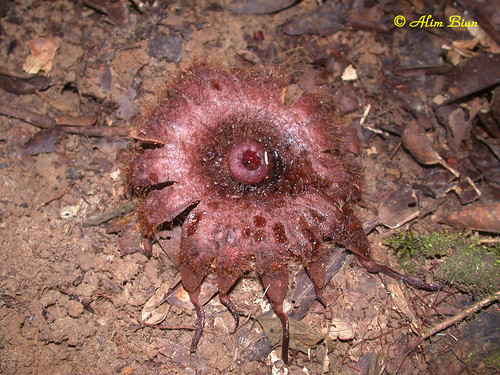


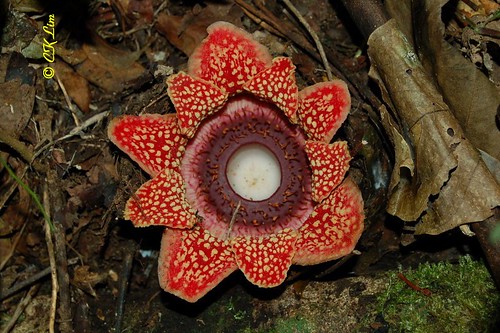

 Although parasitic, Rafflesia species do not typically kill their hosts in spite of the drain on resources that they cause.
Although parasitic, Rafflesia species do not typically kill their hosts in spite of the drain on resources that they cause. 














